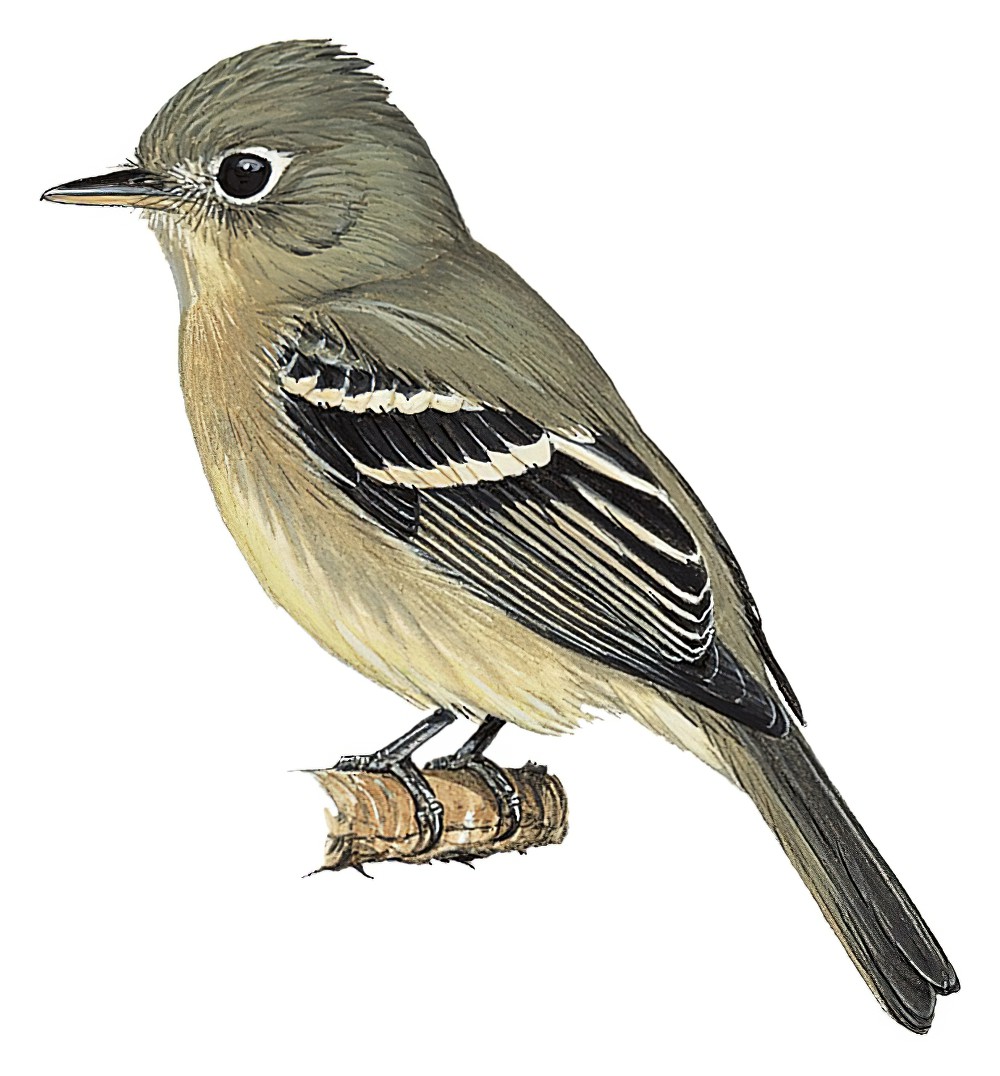Pacific-slope Flycatcher / Empidonax difficilis

Pacific-slope Flycatcher
SCI Name:
Protonym: Empidonax difficilis Rep.Expl.Surv.RR.Pac. 9 p.198
Taxonomy: Passeriformes / Tyrannidae / Empidonax
Taxonomy Code: pasfly
Type Locality: west coast of United States, Fort Steilacoom, Shoalwater Bay, Washington, Fort Tejon, California; restricted to Fort Steilacoom, Washington by Brodkorb, 1949, Condor, 51, p. 39.
Author: Baird, SF
Publish Year: 1858
IUCN Status: Least Concern
DEFINITIONS
EMPIDONAX
(Tyrannidae; Ϯ Acadian Flycatcher E. virescens) Gr. εμπις empis, εμπιδος empidos gnat, mosquito; αναξ anax, ανακτος anaktos lord, master (cf. ναξω naxō will squeeze < νασσω nassō to squeeze (Merriam 1884)); "74. Empidonax pusillus Cab. Tyrannula pusilla Sws. — Myiobius pusillus Gray. Muscicapa pusilla Lembeye. — Moscarita olivada. Dieser Vogel wurde in Habana auf einem platten Dache todt gefunden. ... Die Gattung Empidonax umfasst kleinere und zierlichere Arten, mit schwächerem, weniger entwickeltem Schnabel. Die Flügel sind von mittelmässiger Länge, verhältnissmässig spitzer und länger als bei Myiarchus, jedoch kürzer und weniger zugespitzt als bei Contopus; die Läufe sind verhältnissmässig höher; der Schwanz ist schwach ausgerandet." (Cabanis 1855); "Empidonax Cabanis, 1855, Journ. f. Ornith., 3, p. 480. Type, by monotypy, Empidonax pusillus Cabanis = Platyrhynchus virescens Vieillot." (Traylor in Peters, 1979, VIII, pp. 135-136).
Var. Emipdoanx.
Synon. Cnemonax, Muscaccipiter.
difficilis
L. difficilis difficult, troublesome < dis asunder, apart; facilis easy < facere to make. Coined of species of uncertain systematic position and difficult to allocate, usually as a result of poorly preserved, mutilated, or limited type material.
● "Similar to Cisticola sylvia Reichenow, but striped above and slightly smaller. In general coloration it is not very unlike Cisticola emini Reichenow, though striped and more yellowish above and more strongly fulvous below." (Mearns 1912) (syn. Cisticola natalensis strangei).
● “Although the specimens from the west coast are not sufficiently perfect to allow a full criticism, I am inclined to think that they are really distinct, and that they will not constitute almost the single exception to the fact that no flycatcher is common to both east and west coasts. The colors are lighter, and duller ... The forehead has a peculiar hoary appearance ... In view of all these circumstances, therefore, it may be well to give it provisionally a new name, and none would be more appropriate than that of Empidonax difficilis” (Baird 1858) (Empidonax).
● “The present species was referred by Mr Salvin to G. dentirostris, but the smaller size and differently shaped bill induce me to believe that the two birds are distinct” (Sharpe 1888) (Geospiza).
● "Specimens from the middle area of the Orinoco, the Mérida region, and the state of Carabobo, Venezuela, are referred here with some hesitation. They are not quite typical" (Zimmer 1937) (subsp. Myiodynastes maculatus).
● "Como actualmente não temos presentes os exemplares typicos, não podemos dar descripção mais detalhada; limitamo nos, pois a estes nossos apontamentos e ás informações que amavalmente nos forneceram os srs. Hellmayr e Conde von Berlepsch, ficando reservada para publicação posterior a caracterização mais completa desta especie nova" (Ihering & Ihering 1906) (Phylloscartes).
SUBSPECIES
Pacific-slope Flycatcher (difficilis)
SCI Name: Empidonax difficilis difficilis
difficilis
L. difficilis difficult, troublesome < dis asunder, apart; facilis easy < facere to make. Coined of species of uncertain systematic position and difficult to allocate, usually as a result of poorly preserved, mutilated, or limited type material.
● "Similar to Cisticola sylvia Reichenow, but striped above and slightly smaller. In general coloration it is not very unlike Cisticola emini Reichenow, though striped and more yellowish above and more strongly fulvous below." (Mearns 1912) (syn. Cisticola natalensis strangei).
● “Although the specimens from the west coast are not sufficiently perfect to allow a full criticism, I am inclined to think that they are really distinct, and that they will not constitute almost the single exception to the fact that no flycatcher is common to both east and west coasts. The colors are lighter, and duller ... The forehead has a peculiar hoary appearance ... In view of all these circumstances, therefore, it may be well to give it provisionally a new name, and none would be more appropriate than that of Empidonax difficilis” (Baird 1858) (Empidonax).
● “The present species was referred by Mr Salvin to G. dentirostris, but the smaller size and differently shaped bill induce me to believe that the two birds are distinct” (Sharpe 1888) (Geospiza).
● "Specimens from the middle area of the Orinoco, the Mérida region, and the state of Carabobo, Venezuela, are referred here with some hesitation. They are not quite typical" (Zimmer 1937) (subsp. Myiodynastes maculatus).
● "Como actualmente não temos presentes os exemplares typicos, não podemos dar descripção mais detalhada; limitamo nos, pois a estes nossos apontamentos e ás informações que amavalmente nos forneceram os srs. Hellmayr e Conde von Berlepsch, ficando reservada para publicação posterior a caracterização mais completa desta especie nova" (Ihering & Ihering 1906) (Phylloscartes).
Pacific-slope Flycatcher (insulicola)
SCI Name: Empidonax difficilis insulicola
insulicola
L. insula, insulae island; -cola dweller < colere to inhabit.
● Erroneous TL. San Miguel, Pearl Is., Bay of Panama (= San Miguel, Sierra Nevada de Santa Marta, Colombia) (syn. Thalurania colombica).
Pacific-slope Flycatcher (cineritius)
SCI Name: Empidonax difficilis cineritius
cineritius
L. cineritius or cinericius like ashes, similar to ashes < cinis, cineris ashes.
UPPERCASE: current genus
Uppercase first letter: generic synonym
● and ● See: generic homonyms
lowercase: species and subspecies
●: early names, variants, mispellings
‡: extinct
†: type species
Gr.: ancient Greek
L.: Latin
<: derived from
syn: synonym of
/: separates historical and modern geographic names
ex: based on
TL: type locality
OD: original diagnosis (genus) or original description (species)












